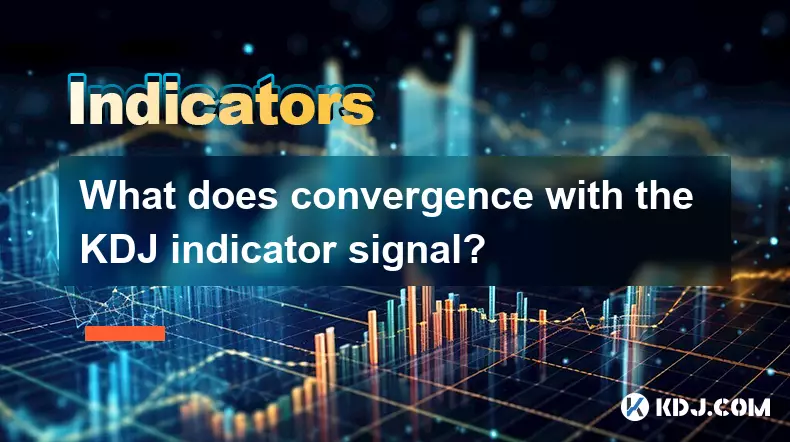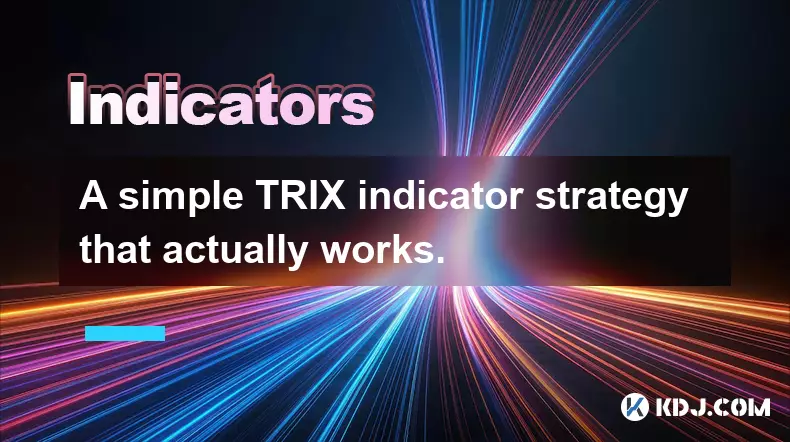-
 bitcoin
bitcoin $101752.865364 USD
-1.09% -
 ethereum
ethereum $3382.985899 USD
-1.38% -
 tether
tether $0.999658 USD
0.04% -
 xrp
xrp $2.272505 USD
-1.51% -
 bnb
bnb $989.089004 USD
0.14% -
 solana
solana $156.962612 USD
-3.08% -
 usd-coin
usd-coin $0.999776 USD
0.01% -
 tron
tron $0.290786 USD
-0.69% -
 dogecoin
dogecoin $0.174594 USD
-2.86% -
 cardano
cardano $0.560085 USD
-3.55% -
 hyperliquid
hyperliquid $40.023704 USD
-5.75% -
 chainlink
chainlink $15.324649 USD
-2.78% -
 bitcoin-cash
bitcoin-cash $493.576540 USD
-3.52% -
 zcash
zcash $571.320038 USD
-12.05% -
 stellar
stellar $0.280066 USD
-4.26%
What does convergence with the KDJ indicator signal?
The KDJ indicator helps crypto traders identify trend strength and reversals by analyzing convergence between price and momentum, with %K, %D, and %J lines offering insights into overbought or oversold conditions.
Nov 06, 2025 at 01:19 pm

Understanding the KDJ Indicator in Cryptocurrency Trading
The KDJ indicator is a momentum oscillator widely used in cryptocurrency trading to identify potential reversal points and overbought or oversold conditions. It combines elements of the Stochastic Oscillator with a smoothing mechanism, introducing three lines: %K, %D, and %J. Traders analyze crossovers and divergences between these lines to make informed decisions. Convergence with the KDJ often indicates alignment between price action and momentum, suggesting a strengthening trend.
Convergence Signals Stronger Trend Validation
- When the price of a cryptocurrency moves in the same direction as the KDJ lines, it reflects positive convergence, meaning market momentum supports the ongoing trend.
- A rising price accompanied by increasing %K and %D values suggests sustained buying pressure within the market.
- In downtrends, if both price and KDJ decline simultaneously, it confirms bearish sentiment and strengthens the likelihood of continued downward movement.
- This form of confirmation reduces false signals commonly seen in volatile digital asset markets.
- Traders use this alignment to reinforce entry or exit strategies, especially when combined with volume analysis or support/resistance levels.
Differentiating Between Convergence and Divergence
- Convergence occurs when price and KDJ move in tandem, reinforcing the current trend's legitimacy.
- Divergence arises when price makes a new high or low unsupported by the KDJ, warning of weakening momentum.
- For example, if Bitcoin reaches a higher high but the KDJ fails to surpass its previous peak, it hints at possible exhaustion.
- Recognizing convergence helps traders avoid mistaking pullbacks for reversals during strong trends.
- The distinction allows for more precise timing when managing leveraged positions or executing swing trades.
Practical Applications in Crypto Markets
- During bull runs in altcoins, consistent convergence on daily charts can signal healthy upward momentum.
- Scalpers monitor short-term convergence on 15-minute or hourly KDJ readings to capture intraday moves.
- Exchanges like Binance or Bybit provide built-in KDJ tools, enabling real-time monitoring across multiple pairs.
- Combining KDJ convergence with moving averages or RSI improves accuracy in spotting continuation patterns.
- Algorithmic trading bots are often programmed to detect KDJ alignment and trigger automated buy/sell orders.
Frequently Asked Questions
What timeframes work best with the KDJ indicator in crypto trading? The 4-hour and daily timeframes are most effective for identifying reliable convergence patterns, particularly for major cryptocurrencies like BTC and ETH. Shorter intervals such as 15 minutes may generate frequent but less accurate signals due to market noise.
Can the KDJ indicator be used alone for trading decisions? Relying solely on the KDJ increases risk due to whipsaws in highly volatile markets. It performs better when integrated with other technical tools such as MACD, volume profiles, or candlestick patterns to confirm signals.
How is the %J line interpreted in convergence scenarios? The %J line, being the most sensitive, often leads %K and %D. When all three lines rise together, especially with %J above 100, it indicates aggressive momentum. Conversely, falling %J alongside price confirms bearish strength.
Does KDJ convergence apply equally across all cryptocurrencies? Larger-cap coins with higher liquidity tend to produce more reliable KDJ signals. Low-cap tokens with erratic volume may distort the indicator, leading to misleading convergence readings that don’t reflect true market structure.
Disclaimer:info@kdj.com
The information provided is not trading advice. kdj.com does not assume any responsibility for any investments made based on the information provided in this article. Cryptocurrencies are highly volatile and it is highly recommended that you invest with caution after thorough research!
If you believe that the content used on this website infringes your copyright, please contact us immediately (info@kdj.com) and we will delete it promptly.
- Ripple (XRP) in 2026: Hold or Fold? A Look at XRP's Future and Emerging DeFi Alternatives
- 2025-11-08 18:35:01
- Zcash ZEC Coin Price Explosion: From Privacy Niche to Center Stage
- 2025-11-08 18:55:01
- Berachain Price Prediction: Navigating the Honeycomb Hype in Crypto
- 2025-11-08 18:55:01
- Arthur Hayes, Gold, and Bitcoin: A Modern Monetary Trinity?
- 2025-11-08 19:15:01
- Shiba Inu's Next Move: Navigating a Shifting Market
- 2025-11-08 19:20:01
- Pakistan's Crypto Crossroads: Balancing Opportunity with Asset-Backed Realities
- 2025-11-08 19:20:01
Related knowledge

How do professional traders use the TRIX indicator?
Nov 06,2025 at 04:40pm
Understanding the TRIX Indicator in Crypto TradingThe TRIX (Triple Exponential Average) indicator is a momentum oscillator used by professional trader...

Can I use the TRIX indicator on my mobile trading app?
Nov 07,2025 at 07:40pm
The TRIX indicator, a momentum oscillator designed to filter out short-term fluctuations and highlight long-term trends, has become increasingly popul...

How to code a simple TRIX indicator script in Pine Script?
Nov 07,2025 at 06:20am
How to Code a Simple TRIX Indicator in Pine Script The TRIX (Triple Exponential Moving Average) indicator is widely used in cryptocurrency trading to ...

A simple TRIX indicator strategy that actually works.
Nov 08,2025 at 05:39pm
Understanding the TRIX Indicator in Crypto Trading1. The TRIX (Triple Exponential Average) indicator is a momentum oscillator designed to filter out s...

How to trade TRIX indicator signals on the 1-hour chart?
Nov 07,2025 at 05:39am
Bitcoin's Role in Decentralized Finance1. Bitcoin remains the cornerstone of decentralized finance, serving as a benchmark for value and security acro...

Can the TRIX indicator be used for long-term investing?
Nov 06,2025 at 02:19pm
Understanding the TRIX Indicator in Cryptocurrency Markets1. The TRIX (Triple Exponential Average) indicator is a momentum oscillator designed to filt...

How do professional traders use the TRIX indicator?
Nov 06,2025 at 04:40pm
Understanding the TRIX Indicator in Crypto TradingThe TRIX (Triple Exponential Average) indicator is a momentum oscillator used by professional trader...

Can I use the TRIX indicator on my mobile trading app?
Nov 07,2025 at 07:40pm
The TRIX indicator, a momentum oscillator designed to filter out short-term fluctuations and highlight long-term trends, has become increasingly popul...

How to code a simple TRIX indicator script in Pine Script?
Nov 07,2025 at 06:20am
How to Code a Simple TRIX Indicator in Pine Script The TRIX (Triple Exponential Moving Average) indicator is widely used in cryptocurrency trading to ...

A simple TRIX indicator strategy that actually works.
Nov 08,2025 at 05:39pm
Understanding the TRIX Indicator in Crypto Trading1. The TRIX (Triple Exponential Average) indicator is a momentum oscillator designed to filter out s...

How to trade TRIX indicator signals on the 1-hour chart?
Nov 07,2025 at 05:39am
Bitcoin's Role in Decentralized Finance1. Bitcoin remains the cornerstone of decentralized finance, serving as a benchmark for value and security acro...

Can the TRIX indicator be used for long-term investing?
Nov 06,2025 at 02:19pm
Understanding the TRIX Indicator in Cryptocurrency Markets1. The TRIX (Triple Exponential Average) indicator is a momentum oscillator designed to filt...
See all articles





















![The Graph Price Prediction [GRT Crypto Price News Today] The Graph Price Prediction [GRT Crypto Price News Today]](/uploads/2025/11/07/cryptocurrencies-news/videos/690d4df44fe69_image_500_375.webp)



















































